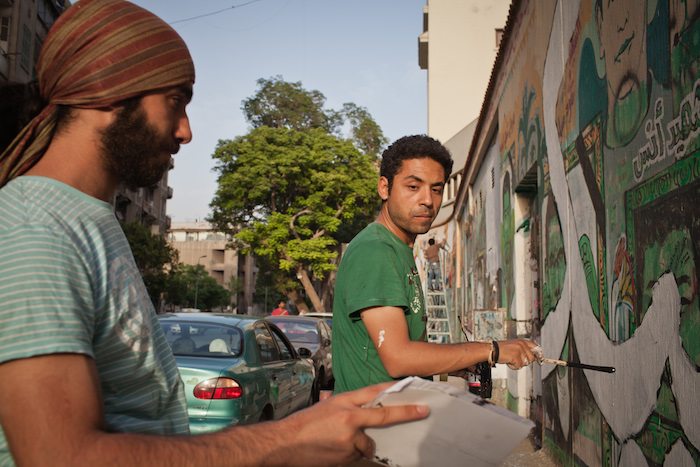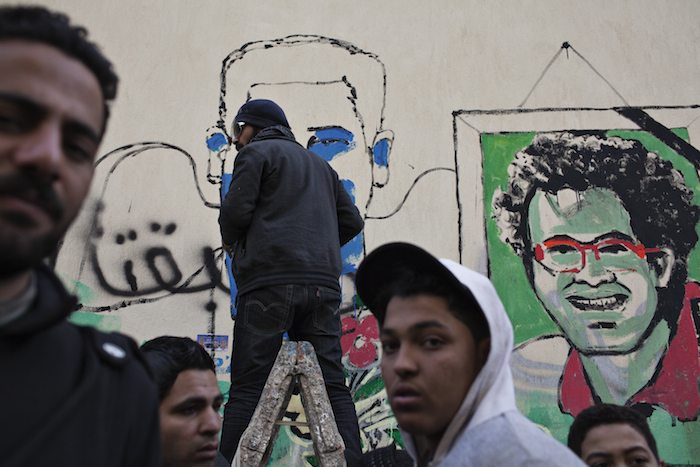Ammar
An engaged graffiti artist
Elusive
We followed him around Luxor for a filming and it was hell. Twice, Ammar ditched us. First, at the airport at 5 a.m., when we had already booked tickets from Cairo for all of us. He ditched us again the next day at 6 a.m this time. He had offered to get up at such an early hour to visit the villages offering the most beautiful murals around Luxor. We went there without him, bitterness in our stomach, teeth clenched and eyes glued from sleep.
Irresistible
One finds it hard to keep a grudge on him. Ammar has the energy of a creator, the brilliance of an artist, and the carelessness of a teenager. He did not wait for the revolution to happen. As professor of Arts at the University of Luxor, he fought alongside others in 2010 against the governor of that time, Samar Farag, a Mubarak henchman. Farag wanted to relocate the university to a new city in the desert, completely astray and disconnected from the places of art and culture which has enriched Luxor over the centuries. “Our plan was to take over the walls of the universities, to create frescos and mosaics. That way, we could stall the move. The buildings became the way our students took exams. So how could they make us move?” says the artist.
Revolutionary
January 25, 2011: the first day of the popular uprising against the Mubarak regime, Ammar was entranced by the “faces” which peopled Tahrir Square. “Young people, old people, poor people, rich people, veiled women, Copts: all of Egypt was there!” After a quick visit to witness the events, Ammar returned to Luxor to do what he does best: draw and show the people of Upper Egypt, too removed from the unrest in Tahrir to care about what was going on in the revolution. “I wrote messages on walls: ‘Be patient, he will be out! Get involved, it’s now or never.’ The police erased my work several times. I suddenly understood how important it was to continue.”
Heir
Before the revolution, Ammar did not consider himself to be a graffiti artist. He initially chose concrete as a medium and the street as the exhibition space, wanting only to express his anger but at the same time re-establishing a link between the Egyptians and their own culture. “I am fascinated by folk art, by the paintings which adorn the walls of the houses in the south, depicting daily life, the pilgrimage to Mecca, and the most notable people of the village. Today, after dozens of years of a dictatorship and influence from abroad, from Saudi Arabia notably, these drawings no longer exist. Gaudy mosques were built over old buildings which contain treasures and are an important part of our heritage. But the people here are like those who have adopted a new culture.” This is why Ammar tirelessly spray paints Mohamed Mahmoud, the street adjacent to Tahrir Square, whose walls have for months become a gallery of young Egyptian artists. It is on this street that several martyrs have been killed by police during the insurrection of last November. “What is important is to occupy this place, show people what is going on, and never forget who made this revolution happen and paid a dear price for it. To not be brainwashed by anything the State media says.” On the street Mohamed Mahmoud, Ammar has painted the portraits of several football fans who were killed during the massacre at Port Said Stadium on February 1, 2012. The faces are sometimes smiling and sometimes very serious, painted in vivid colours, larger than life, with wings unfurling from their backs. “These are the wings of the Coptic saints that we see in the churches,” Ammar explains. It is another way to remind Egyptians that their artistic legacy is diverse, influenced as much by the Copts as it is by the Pharaohs or by Islam.
Ammar is one of the central characters of Tahrir Generation, a web documentary coupled with its own documentary installment, which depicts the Egyptian youth after the revolution. It is the story of the youth which made Tahrir happen: the youth which emerged after and suffered as a result of it. Inshallah, the project will see the day next September.
In the meantime, you can read more on our blog and if the project moves you, you can even become a generous contributor through the funding website Kiss Kiss Bank Bank.
Photo credit Pauline Beugnies. Translation by Adam Dexter, edits by Laïla von Alvensleben.
4 thoughts on “Ammar”
Leave a Reply
You must be logged in to post a comment.











Ammar has been my friend for many years. Most of the time his erratic behaviour drives me crazy. But what we must never forget is that he is possessed by his work. And how brilliantly that work has evolved over the years. It is his life and, for him, everything else must come second. It is not easy to be patient with him at times but then, when you see him at work, you realize what he is. Frustration is a small price to pay for being his friend. It is an honour to be driven crazy by genius.